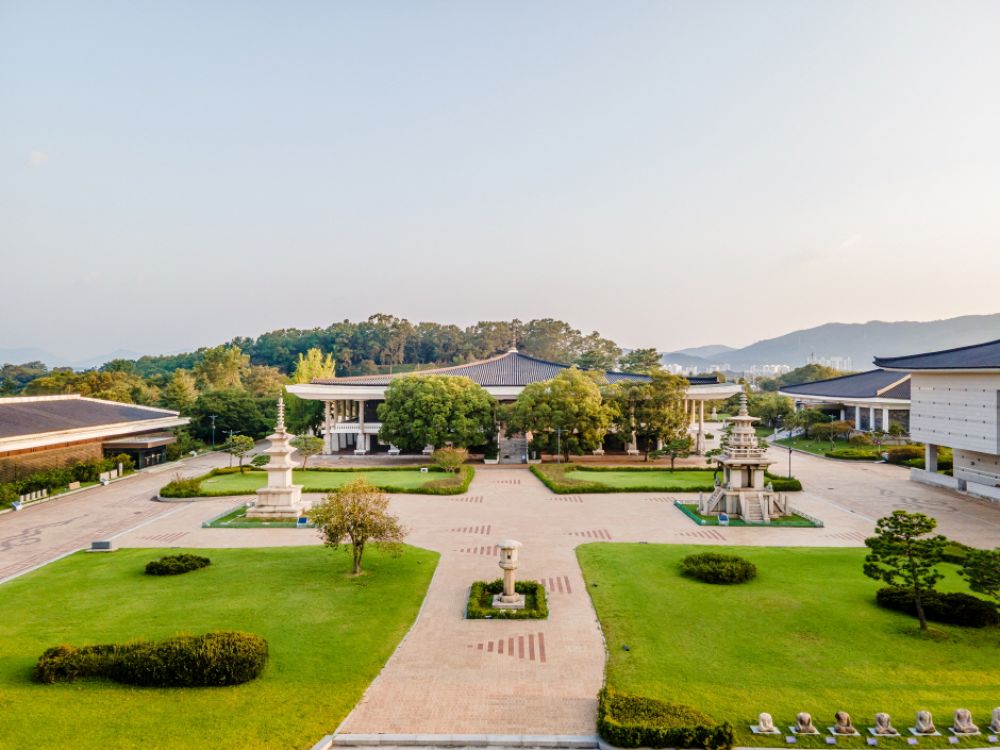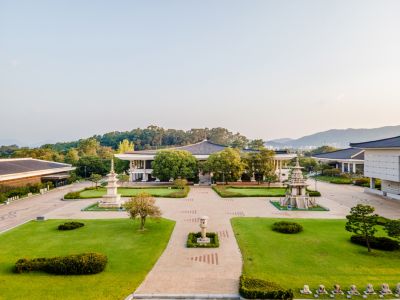

The Gyeongju National Museum houses a wealth of artifacts from the Silla kingdom, which once had its capital in Gyeongju. Visitors can delve into the rich history of the area through the museum's diverse permanent exhibitions. The museum's collection includes splendid Buddhist art, precious metalwork, and ceramics. Among these are the Emille Bell, an iconic symbol of Gyeongju, and treasures excavated from the Cheonmachong Tomb. Each exhibit tells a story of Silla's sophisticated culture, providing insights into the artistic and technological advancements of the era. The layout leads you naturally from one gallery to another, taking you through Korea's intriguing ancestry and the Silla dynasty's golden age.
The Silla Kingdom History Hall is a specialized zone within the Gyeongju National Museum dedicated to showcasing the evolution and power of the Silla Kingdom, which lasted nearly a thousand years. Visitors can immerse themselves in an educational journey, observing the Silla's political history, culture, and Buddhism's influence on the region. The hall includes interactive displays and well-preserved relics that bring the Silla period to life. One can spend ample time examining ancient texts, architectural fragments, and royal artifacts that provide a narrative of how the kingdom thrived due to its robust governance, cultural sophistication, and trade.
The Buddhist Art Gallery in Gyeongju National Museum is a treasure trove of Buddhist artifacts, displaying an array of sculptures, pagodas, and reliquaries. The gallery emphasizes the transformation and spread of Buddhism within Korea. Visitors will have the chance to witness the depths of spiritual devotion and artistry through the exhibit's highlights, such as gilt-bronze statues and delicate stone pagodas. Significant attention is given to the aesthetic details and symbolic meanings behind each piece. The gallery encapsulates the serene essence of Buddhism, encapsulating its influence on the Korean peninsula, especially during the Silla dynasty.
The Gyeongju National Museum also offers visitors a range of cultural experience programs that provide a hands-on approach to understanding the Silla culture. These programs often include traditional Korean crafts, such as making lotus lanterns, learning about Korean metalwork, or trying out traditional Silla painting techniques. Participants not only enjoy creating their souvenirs, but also gain a deeper appreciation for the skills and art forms that have been passed down through generations. Such programs are a fantastic way to get a tactile experience of history, perfect for families and individuals seeking to immerse themselves in Korean traditions.
The Gyeongju National Museum is not confined to its indoor exhibitions; several significant outdoor exhibits can be explored within its grounds. These include the Divine Bell of King Seongdeok (also known as the Emille Bell), stone pagodas, and Buddhist statues. Walking among these treasures, guests can experience the grandeur of Silla's monumental architecture and sculpture. Insightful descriptions accompany each artifact, allowing for self-guided tours where visitors can take in the history at their own pace. The outdoor exhibits, strategically positioned among manicured gardens, provide a picturesque backdrop for learning and reflection.
Throughout the year, the Gyeongju National Museum curates special exhibitions that offer a more in-depth look at specific aspects of the Silla culture or periods of Korean history. These exhibitions often feature rare artifacts that are not part of the permanent display, loaned items from other cultural institutions, or thematic shows that explore particular narratives of Silla's past. These temporary exhibitions are meticulously planned and richly informative, providing guests with fresh perspectives and reasons to revisit. They offer a dynamic addition to the museum's schedule, and many are keenly anticipated by history enthusiasts and cultural scholars alike.
Educational programs at the Gyeongju National Museum cater to a variety of audiences, from school children to adult learners. These programs often relate to the current exhibitions and include guided tours, lectures, and workshops led by experts. Aiming to broaden historical knowledge and awareness of Silla culture, these programs enrich the visitor experience with engaging learning opportunities. Some of the programs may explore the traditional techniques used in creating artifacts, while others could delve into the historical significance of specific pieces in the museum's collection.
The Gyeongju National Museum utilizes its auditorium to host regular film screenings that connect cinema with history. The films selected are often historical dramas, documentaries, or educational features relevant to Korean history and the Silla period in particular. These screenings are a unique way to visualize the lives of people during the dynasty and to understand the stories behind the artifacts on display. The immersive cinematic experience complements the museum's exhibits, making history accessible and entertaining for a wide audience.
For researchers and history buffs, the Gyeongju National Museum offers access to its extensive archives and library. Housing a vast collection of texts, papers, and digital media related to Korean history and art, the library is an invaluable resource for those looking to conduct scholarly research or simply wanting to learn more about Silla culture. Access to some materials may require advance arrangements or guided assistance, ensuring that the artifacts and documents are preserved for future generations.
No visit to the Gyeongju National Museum would be complete without stopping by the museum's gift shop. Here, visitors can find a wide range of souvenirs, from books and postcards to replicas of artifacts and traditional Korean handicrafts. These items not only serve as mementos of their visit but also help support the museum's mission to preserve and promote the history of the Silla kingdom. Shoppers can choose from a variety of goods that reflect the aesthetic and cultural values of the region's past, making for unique gifts and keepsakes.
